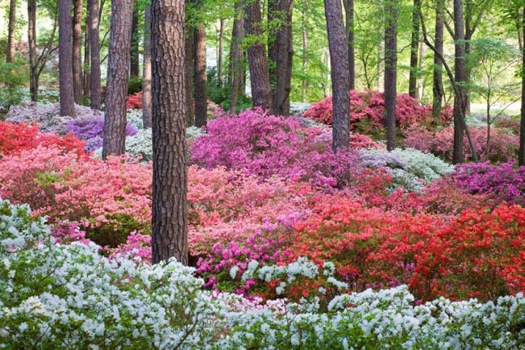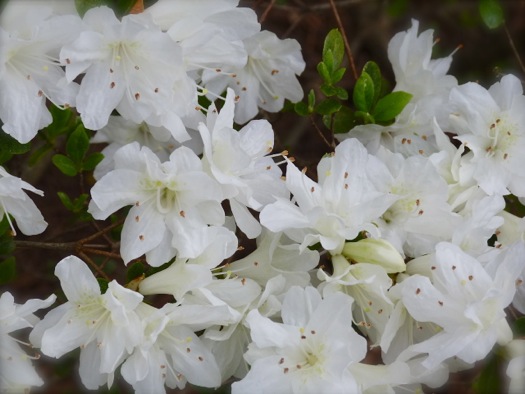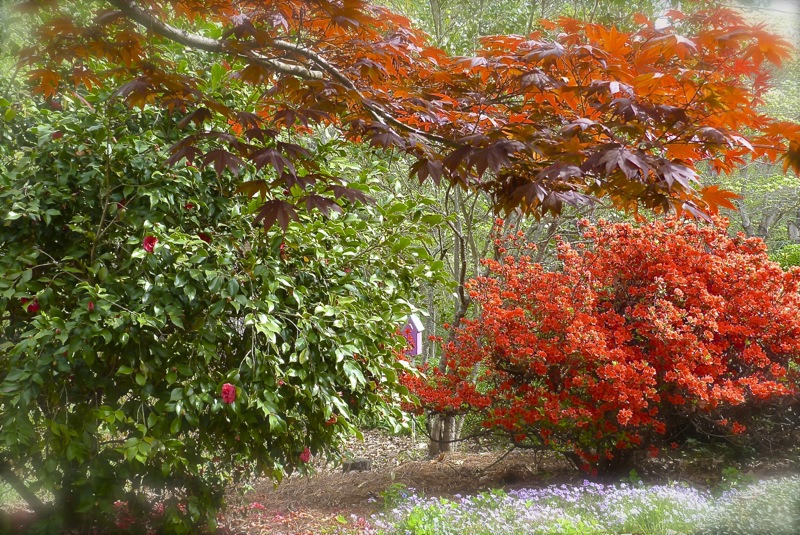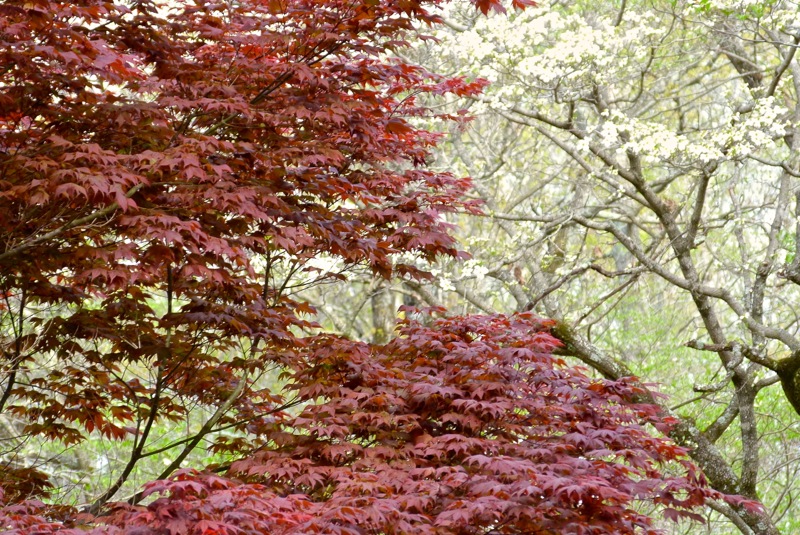How to Plant and Care For Azaleas
 Saturday, March 14, 2015 at 9:20PM
Saturday, March 14, 2015 at 9:20PM One spring we visited Calloway Gardens in Pine Mountain, Georgia, just as the azaleas were at their peak. I have never forgotten the swaths of candy colored shrubs that blanketed the woodlands. Since then I have dreamed of a similar effect in my own garden, although on a much smaller scale!
I have never forgotten the swaths of candy colored shrubs that blanketed the woodlands. Since then I have dreamed of a similar effect in my own garden, although on a much smaller scale!
I am speaking of azaleas in this post, but the planting and care of rhododendrons is very similar. Azaleas and rhododendrons are all in the genus Rhododendron, with thousands of named selections. All azaleas are rhododendrons, but not all rhododendrons are azaleas! It is fairly easy to tell the difference. Generally, rhododendrons have much larger, leathery leaves. Many rhododendrons will not grow well in the sub-tropical southeastern US, while azaleas, which love warm air and humidity, can flourish here as well as in the Middle and Upper South. Depending on the variety, azaleas will grow in USDA hardiness zones 5-8.
 Azaleas blooming April, 2014 in my front garden
Azaleas blooming April, 2014 in my front garden
While iconic images of the Deep South often include azaleas, these plants are not necessarily easy to grow. The secret is site selection and planting. The best site receives morning sun and afternoon shade. Too much sun will make azaleas susceptible to lace bugs. Too much shade will cause lanky growth and decreased flower production. Filtered light under tall pine and oak trees is ideal. Some azaleas, such as the Encore series, can take more sun than others. Do not plant near shallow-rooted trees that will compete for moisture and nutrients. Azaleas also need acidic soil with a pH of somewhere between 4.5 and 6.
Moist, well-drained soil is an absolute requirement for all azaleas. If one sticks an azalea in unimproved clay soil, it will die. Azaleas have shallow, delicate roots, and they must have friable soil in order to reach out for nutrients and water. These fine roots will drown in standing water, and they also will quickly smother in hard, compacted soil. Poorly drained soil will also promote die-back due to soil-borne fungus.
Like many gardeners in my area, I have clay soil. There are two solutions to this problem. Probably the easiest thing to do is to build a berm or raised bed about 8 to 12 inches high. Fill the bed with 50 percent good garden soil and 50 percent organic matter such as pine bark, peat moss, compost or chopped up oak leaves. Plant the azalea high with one to two inches of its root ball above ground. Then pull the improved soil up to the top of the root ball, forming a mound. Mulch with about three inches of shredded leaves, pine bark or pine needles. The mulch will conserve moisture, suppress weeds, and help keep the shallow roots cool during the hot summer. The mulch should not actually touch the azalea but should be applied like a wide doughnut around the stem.  Kurume azalea 'Snow' grows in my front garden.
Kurume azalea 'Snow' grows in my front garden.
To plant an azalea directly in the ground, dig a hole at least a foot deep and about three times as wide as the root ball. Fill the lower half of the hole with a mixture of 50 percent native soil and 50 percent organic matter. Place the azalea so that one to two inches of its root ball is above ground. Then fill the remainder of the hole with organic matter. Pull the organic matter up to the top of the root ball, forming a mound, and mulch with about three inches of shredded leaves, pine bark or pine needles. As mentioned above, the mulch should be applied so that it does not actually touch the azalea's stem.
Be sure to loosen the roots and water the azalea before planting. If root bound, use a sharp knife to make several vertical cuts around the perimeter of the root ball. Then gently loosen the roots as much as possible.
Once planted, slowly and thoroughly water. Continue to water the azalea two or three times a week until the roots are well-established. This is why I like to plant azaleas in the fall. I rarely have to water them once our winter rains begin. Soil here in the Deep South does not freeze, so the roots have winter and spring to establish themselves before the stressful heat of summer arrives. Azaleas need consistent moisture, about one inch of rain per week during the hot summer. If nature doesn't provide it, the gardener must. But remember: too much water can be just as harmful as too little! Azaleas will absorb water through their leaves, as well as their roots, so overhead watering is beneficial. It is best to water in the morning so the leaves dry by afternoon. Damp leaves in the evening hours can promote growth of fungus.
Azaleas in rich, acid soil require little or no fertilizing. If the pH of the soil is too high, the leaves will demonstrate chlorosis, or yellowing. If needed, cottonseed meal or a fertilizer for acid-loving plants should be applied after flowering has finished in the spring.
Azaleas are more attractive if allowed to grow into their natural shape, rather than sheared into tight balls, which is the habit of many who plant these as foundation shrubs. The brilliant orange Kurume azalea on the right has been growing in my garden for many years. At about four feet tall, it needs minimal pruning.To avoid cutting off next year's blooms, lightly prune by snipping off spent flower stalks in spring just after blooming has ended. This is also a good time to apply fresh mulch. Azaleas can be rejuvenated by drastic pruning, down as far as one foot of the ground. Do this in late winter or early spring, but remember you will lose the spring blooms.
The brilliant orange Kurume azalea on the right has been growing in my garden for many years. At about four feet tall, it needs minimal pruning.To avoid cutting off next year's blooms, lightly prune by snipping off spent flower stalks in spring just after blooming has ended. This is also a good time to apply fresh mulch. Azaleas can be rejuvenated by drastic pruning, down as far as one foot of the ground. Do this in late winter or early spring, but remember you will lose the spring blooms.
Both adult lace bugs and their immature form, called nymphs, damage azaleas by sucking sap from leaves. Leaves develop a grayish cast with a speckled or stippled appearance. If damage is severe, the leaf will appear white and will drop early. The insects feed on the underside of the leaves, so close inspection of the underside will reveal shiny black bits of insect droppings. I thoroughly spray my azaleas with horticultural oil, five tablespoons per gallon of water, in early spring as a preventative against these and other insects that may afflict azaleas. If harmful insect populations are allowed to grow, stronger insecticides may be required.
 A butterfly enjoys the nectar from my 'George L.Taber' azalea, a Southern Indica Hybrid.There are many varieties of azaleas, and they all are attractive to hummingbirds, butterflies and other pollinators. Some grow low to the ground, and some will grow up to 25 feet. Choices include exotic evergreen azaleas and native deciduous azaleas.
A butterfly enjoys the nectar from my 'George L.Taber' azalea, a Southern Indica Hybrid.There are many varieties of azaleas, and they all are attractive to hummingbirds, butterflies and other pollinators. Some grow low to the ground, and some will grow up to 25 feet. Choices include exotic evergreen azaleas and native deciduous azaleas. These native azaleas are growing at John's Native Gardens near Scottsboro, Alabama. Their willowy, upright forms look best in a natural setting.By choosing different types of azaleas, including the re-blooming Encore varieties, one can experience their blooms from spring through fall. If well planted and cared-for, these beautiful shrubs will return the investment many times over.
These native azaleas are growing at John's Native Gardens near Scottsboro, Alabama. Their willowy, upright forms look best in a natural setting.By choosing different types of azaleas, including the re-blooming Encore varieties, one can experience their blooms from spring through fall. If well planted and cared-for, these beautiful shrubs will return the investment many times over.  The deciduous native azalea 'Florida Flame' has glowing orange blooms that light up my woodland garden in April.
The deciduous native azalea 'Florida Flame' has glowing orange blooms that light up my woodland garden in April.





